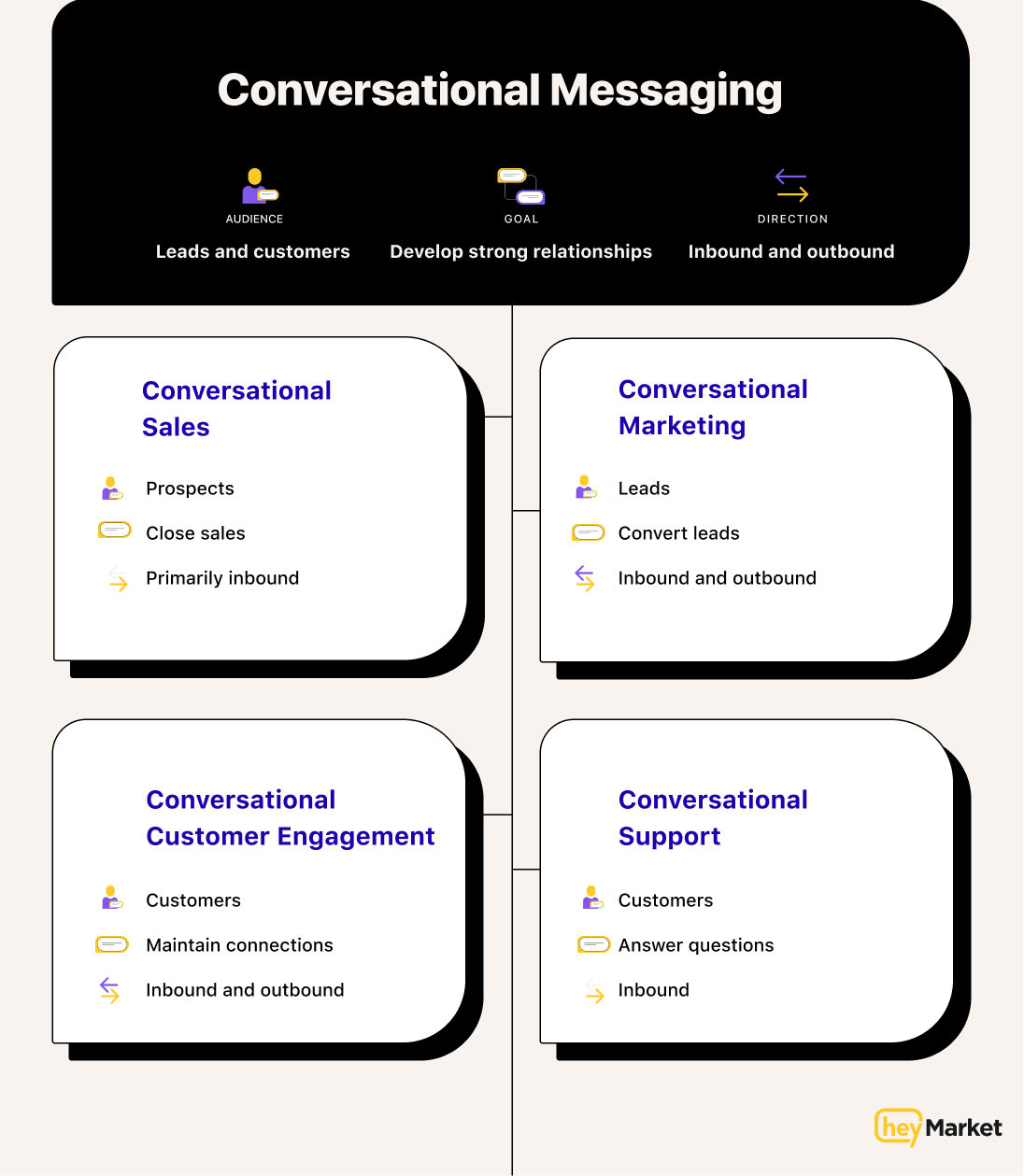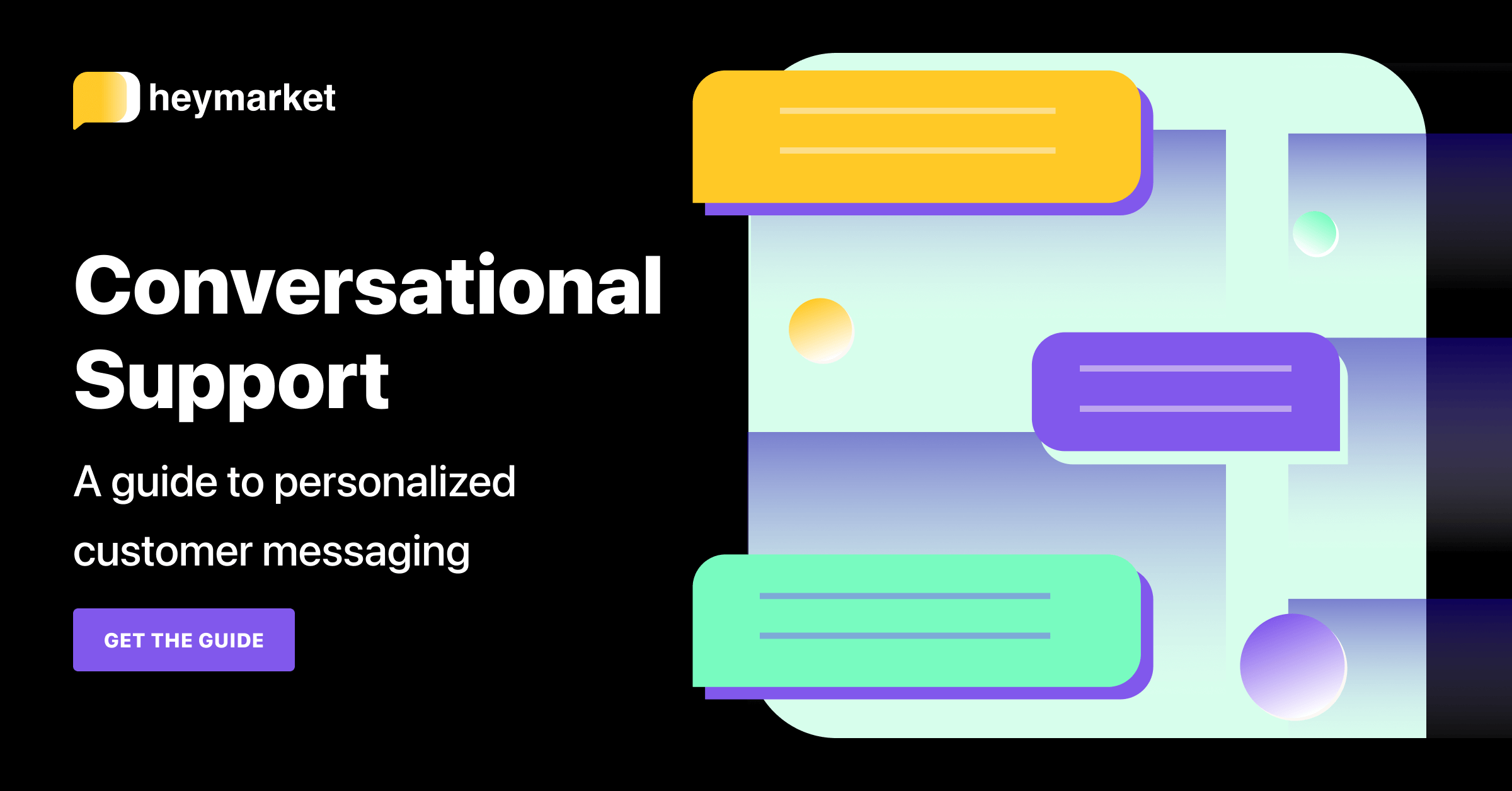Customers increasingly turn to online shopping, moving away from traditional brick-and-mortar stores. In fact, experts predict that consumers will spend nearly $11 trillion on online purchases in 2024 alone.
With customers spending more time online, it’s essential to focus on digital communication channels, meeting their expectations for speedy responses and personalized interactions. Conversational messaging—the strategy of prioritizing one-to-one chats between customers and live agents—has emerged as a powerful new tool for satisfying those needs.
In this article, we define conversational messaging, explain why it’s so effective for online customer service, and explore four subtypes you can use in day-to-day interactions with your customers.
What is conversational messaging?
Conversational messaging is the strategy of communicating with leads and customers through one-to-one conversations on any messaging channel. It’s a broad topic encompassing any kind of personalized chats you have with customers over messaging.
Within the umbrella concept of conversational messaging, there are four sub-categories:
- Conversational marketing
- Conversational sales
- Conversational support
- Conversational customer engagement
Each of these subcategories outlines a more specific strategy for using conversational messaging at a key point in the customer journey.
Conversational messaging has several central tenets that you should follow. It:
- Occurs on customers’ schedules. Customers can message your team at any time they please. That doesn’t mean your team needs to respond right then and there; you can send automated messages that set expectations about response times. In other words, these conversations are asynchronous.
- Yields fast responses. Customers can expect fast replies, no matter whether a team is messaging ten or fifty customers at once.
- Is personalized. Customers can expect agents to know about past brand interactions and customer history.
- Offers multiple entry points. Customers can use the channels they enjoy the most, such as native SMS, Facebook Messenger, Instagram Messaging, WhatsApp, Apple Messages for Business, and Google’s Business Messages.
For comparison, traditional customer service:
- Forces customers to wait in line and/or focus solely on their service issue. This is the case for both in-person customer service and channels like phone calls. Customers have to dedicate their time to waiting in line or waiting on a phone call. With conversational messaging, customers can message in and review your team’s response whenever they get time.
- Can be slow. The average customer support ticket resolution time is nearly four days. This extra time is often due to channels like email, which customers check less frequently if they check it at all. (The average email open rate is 21%.) Slower responses lead to slower resolution times. Because customers are more likely to read messages—for example, 98% of texts are read—your team can resolve queries faster.
- Offers few entry points. Back in the day, customers had to come into a physical store to get help. Most brands offer more options today, such as a phone number to call or an email address. With conversational messaging, teams offer at least six messaging options so customers can more easily get help.
In other words, unlike traditional customer service, conversational messaging helps you meet customers where they are, encouraging long-lasting relationships.
Want to learn more about using conversational messaging to support customers? Read our ebook Conversational Support: A Guide to Personalized Customer Messaging.
Why messaging?
Customers love messaging. The four largest messaging platforms have more active users than the four largest social media platforms (4.1 billion vs. 3.4 billion).
But they don’t just want to chat with robots. They want to make connections with human agents; more than one third of U.S. residents believe one of the top three keys to a happy customer service interaction is a human representative. Forty-four percent say they want companies to be more open about how to connect with another person.
They also want speed: 90% of customers rate an “immediate” response as essential or very important when they have a customer service question, and “immediate” is defined as 10 minutes or less.
Conversational messaging meets each of these three customer needs. It is human-based, fast, and based on customers’ favorite messaging channels. Plus, it helps you answer more customer questions, faster.
Types of conversational messaging
Conversational messaging can be used for customer support and engagement, marketing, and sales. All four of these conversational approaches can easily integrate into your current strategies.

Conversational support
Conversational support refers to live team members answering customers’ questions through personalized conversations. It focuses on educating and troubleshooting with customers through one-on-one chats.
This strategy works similarly to customer support through email, though it’s a lot faster. Customers tend to respond quickly, and team members can manage several chats at once. You can use conversational support to:
- Answer inbound questions
- Support customer onboarding
- Troubleshoot product problems
- Send order and delivery updates
- Start returns
- Follow up after customer interactions
Like all conversational messaging strategies, the goal of conversational support is to build long-lasting customer relationships. Having service and support conversations with real people helps customers grow closer with your brand.

For a deeper look at conversational support, check out our guide.
Get the guideConversational engagement
Conversational engagement, or conversational customer engagement, is similar to conversational support. However, it focuses more on keeping current customers connected to your brand through a mix of inbound and outbound messages.
This strategy functions in a similar way to engagement through many other channels. However, you can expect more (and faster) responses. You can use conversational engagement to:
- Invite customers to text in with questions
- Share brand news or product updates
- Check on order or ticket satisfaction
- Ask for feedback or reviews
Businesses have a wide variety of use cases for conversational engagement. You may use it to boost sales or increase customer loyalty. The focus you choose depends on your team’s current priorities. It should all come back to keeping customers actively involved with your brand.
Conversational marketing
Conversational marketing emphasizes answering questions that leads have about your products and services, and engaging them with outbound content. The strategy offers opportunities for lead outreach, but it focuses on incoming queries.
You can use conversational marketing to:
- Encourage leads and customers to reach out through brand-specific messaging programs (e.g., text in for recipes or wine pairing suggestions)
- Send product tips and tricks
- Create opinion polls (and share the results)
- Ensure leads and customers know that they can reply and engage with your team
- Answer incoming lead queries with indirect marketing techniques (or pass them to sales teams)
This strategy is a powerful way to turn leads into customers through engaging, convenient content that offers the possibility of two-way conversations.
Conversational sales
Conversational sales asks sales teams to focus on responding to inbound leads. It’s all about making it easier for customers to ask questions about your services or products, leading to faster sales through one-on-one conversations.
You can use conversational sales to:
- Answer lead questions about how your products or services work
- Remind leads about completing their purchases
- Guide leads through the closing process
- Follow up with leads
Connecting with leads when they’re actively asking questions ensures you’re chatting with high-intent prospects who are ready to talk with sales. Answering their questions at these key moments also helps close sales quickly.
Conversational messaging in practice
Conversational messaging addresses customers’ preference for online shopping as well as their desire for authentic, person-to-person conversations with business representatives. Now that you’ve been introduced to conversational messaging, you know how to better reach customers where they are with the speed they want and the human interactions they need.
Conversational approaches help you move away from quick closes (and immediate communication drop-offs) and toward ongoing conversations. Ongoing conversations can bloom into strong, personalized customer relationships that produce more brand loyalists in the long term.
Ultimately, conversational messaging is a modern, easy-to-use, effective strategy that helps you make real, lasting connections with your customers.
Want a step-by-step framework for supporting your customers with conversations to build strong relationships? Check out our Conversational Support Guide.






